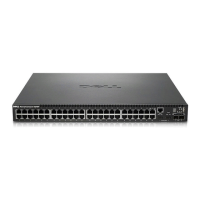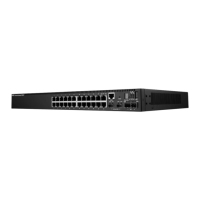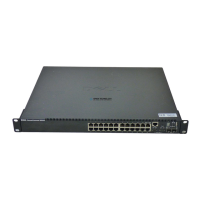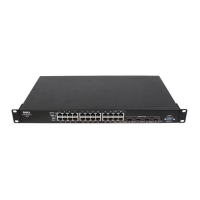
Do you have a question about the Dell POWERCONNECT 5524P and is the answer not in the manual?
Details system support for up to eight units with fixed HDMI stacking ports, including features like failover and auto-synchronization.
Explains PoE functionality, providing power to devices over LAN cabling without needing separate power sources.
Describes Spanning Tree Protocol (STP) features for preventing Layer 2 forwarding loops and managing network topography.
Discusses features for prioritizing network traffic, including 802.1p support and DSCP values.
Describes the different PowerConnect 5500 switch types and their port configurations.
Details the physical structure of the devices, including the front panel, buttons, LEDs, and back panel.
Explains how the stacking feature provides multiple switch management through a single switch.
Describes how to configure the stack, including adding units and assigning unique IDs.
Outlines the sequential steps to configure switches in a stack for initial setup and management.
Explains that the switch is considered a stack even if it's a single switch, and individual configuration is required.
Guides users through the initial switch configuration process using an automated setup wizard.
Provides general information for using the Command Line Interface (CLI) for switch configuration operations.
Covers system security handled by AAA, data encryption via SSH, and password configuration for various services.
Enhances network security by limiting port access to users with specific MAC addresses, offering Classic and Limited Dynamic Lock modes.
Enables defining classification actions and rules for specific ingress or egress ports, composed of Access Control Entries (ACEs).
Provides port-based authentication for system users via an external server using EAP and Dynamic VLAN Assignment.
Describes how to view and set general switch parameters, including asset information, system health, and power over Ethernet.
Explains how to set the system clock manually or receive date/time from an SNTP server for accurate time synchronization.
Details the Logs feature for keeping independent logs of system events, including severity levels and destinations.
Covers configuring IP addresses on the switch, including IPv4 and IPv6 addressing, DHCP, static routing, and DNS.
Explains pages used to manage device security, including access profiles, authentication, and password management.
Details the switch's ability to operate as a DHCP server, allocating IP addresses to devices and managing network pools.
Describes how to manage device firmware (image files) and configuration files, including download, upload, and system files.
Covers managing the stack, including overview, unit IDs, versions, reset, and unit identification.
Provides Layer 2 isolation between interfaces sharing the same Broadcast domain (VLAN), enabling similar services grouping.
Describes how to modify port settings, including description, port type, admin status, speed, and duplex modes.
Details how to configure Link Aggregation Groups (LAGs), supporting up to 32 LAGs per system.
Provides the ability to limit the number of frames entering the switch and define frame types counted towards this limit.
Describes how static MAC addresses are manually assigned to specific interfaces and VLANs.
Details the Dynamic Address Table, which stores MAC addresses acquired by monitoring source addresses of traffic.
Describes STP's role in providing tree topography, eliminating loops, and supporting Classic, Rapid, and Multiple STP versions.
Explains how to enable STP and select the STP mode (Classic, Rapid, or Multiple) on the device.
Details how to assign STP properties to individual ports, including enable/disable STP, Fast Link, and BPDU Guard.
Describes how to assign STP parameters to LAGs, covering enable/disable STP, Fast Link, BPDU Guard, and Root Guard.
Explains RSTP's ability to detect and use network topologies for faster spanning tree convergence without creating forwarding loops.
Describes MSTP, which maps VLANs into STP instances for load balancing and separate loop detection/mitigation.
Explains VLANs as logically segmented networks for organizational basis, functions, or applications, providing segmentation services.
Details how to view ports in a VLAN and assign parameters, including port labeling for VLAN membership status.
Describes how to assign ports to VLANs, configure port VLAN mode, and set acceptable frame types.
Enables enhancement of VoIP service by configuring ports to carry IP-voice traffic on a specific VLAN with a QoS profile.
Explains how link aggregation optimizes port usage by linking ports to form a single LAG (aggregated group) for increased bandwidth.
Details how to define LACP LAGs by configuring global and port parameters like system priority, timeout, and port priority.
Configures interfaces as trusted to receive packets only from within the network or firewall, disabling inspection for these packets.
Describes DHCP snooping, which expands network security by providing layer security between untrusted interfaces and DHCP servers.
Explains DHCP relay functionality, allowing the switch to act as a DHCP Relay agent to listen for and relay messages between servers and clients.
Explains QoS for optimizing network performance by classifying incoming traffic into classes based on attributes.
Describes QoS Basic mode, defining a trusted domain, packet marking, and basic mode configuration workflow.
Details QoS Advanced mode, using policies for per-flow QoS, class maps, policers, and binding.











